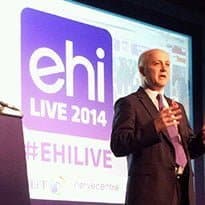The National Information Board will publish a framework next week to make sure the NHS can “get behind” the information revolution promises of the ‘Five Year Forward View’.
Speaking at EHI Live 2014 this morning, Tim Kelsey, NHS England’s director of patients and information, said the long-awaited strategy would address the 5YFV’s themes of encouraging people to take control of their own health and care and helping the NHS to improve quality and efficiency.
He said it would also tackle the issue of trust, with an expansion of the audit data in the My NHS section of NHS Choices, and new audit trails to show people who had accessed their health records and what they had done with the information.
“I am optimistic,” Kelsey told the first keynote event of the show at the NEC in Birmingham. “The NHS is speaking with a single voice on how to build the future, and that is a new tone on what we have had before. The digital revolution is upon us. We must embrace it.”
The 5YFV was published last month by NHS England chief executive Simon Stevens to outline ways in which the NHS could close the thirty billion pound funding gap that could open up between funding and demand by 2020-21.
It promised a set of ‘roadmaps’ to outline the role of IT and information, in place of the IT strategy that has been promised since NHS England issued its ‘building an integrated digital care record’ guidance for bids to the technology fund last July.
Kelsey said the framework that will be put out by the NIB will be called ‘Personalising Health and Care 2020’ and that it will have a number of themes.
In his speech, he highlighted the importance of apps, of giving clinicians real-time access to information, and of building trust with patients and users.
On apps, he said there would be a voluntary scheme for app developers to gain an NHS ‘kitemark’ that would also enable them to put their apps on NHS Choices “and in some cases have GPs prescribe them.”
He argued this would give users confidence that “the app does what it says it will do.” He also said he wanted to see an expansion of current plans to give patients access to GP records, booking and prescription services, so these worked “across all health and social care interfaces.”
On the broader IT and information agenda, he said the framework would put an emphasis on integration and information sharing, and support for hospitals and other providers to “move into the digital future.”
In response to a question on how to change attitudes towards IT, he said the framework would not focus on “gadgets and gizmos” but on why innovations, such as bedside observation systems, had failed to become “embedded’ in day to day working; and on how to address this.
He reiterated earlier comments suggesting that arms-length regulatory bodies might have a role to play, by withdrawing funding or training accreditation from providers that did not implement the systems to provide them with “concrete, real-time” proof of the outcomes they were delivering for patients.
“It is about the alignment of legal pressures and regulatory incentives to encourage change,” he concluded. “Chief clinical information officers and other clinical leaders are the ambassadors for change, but we have to find some concrete ways to support them.”

